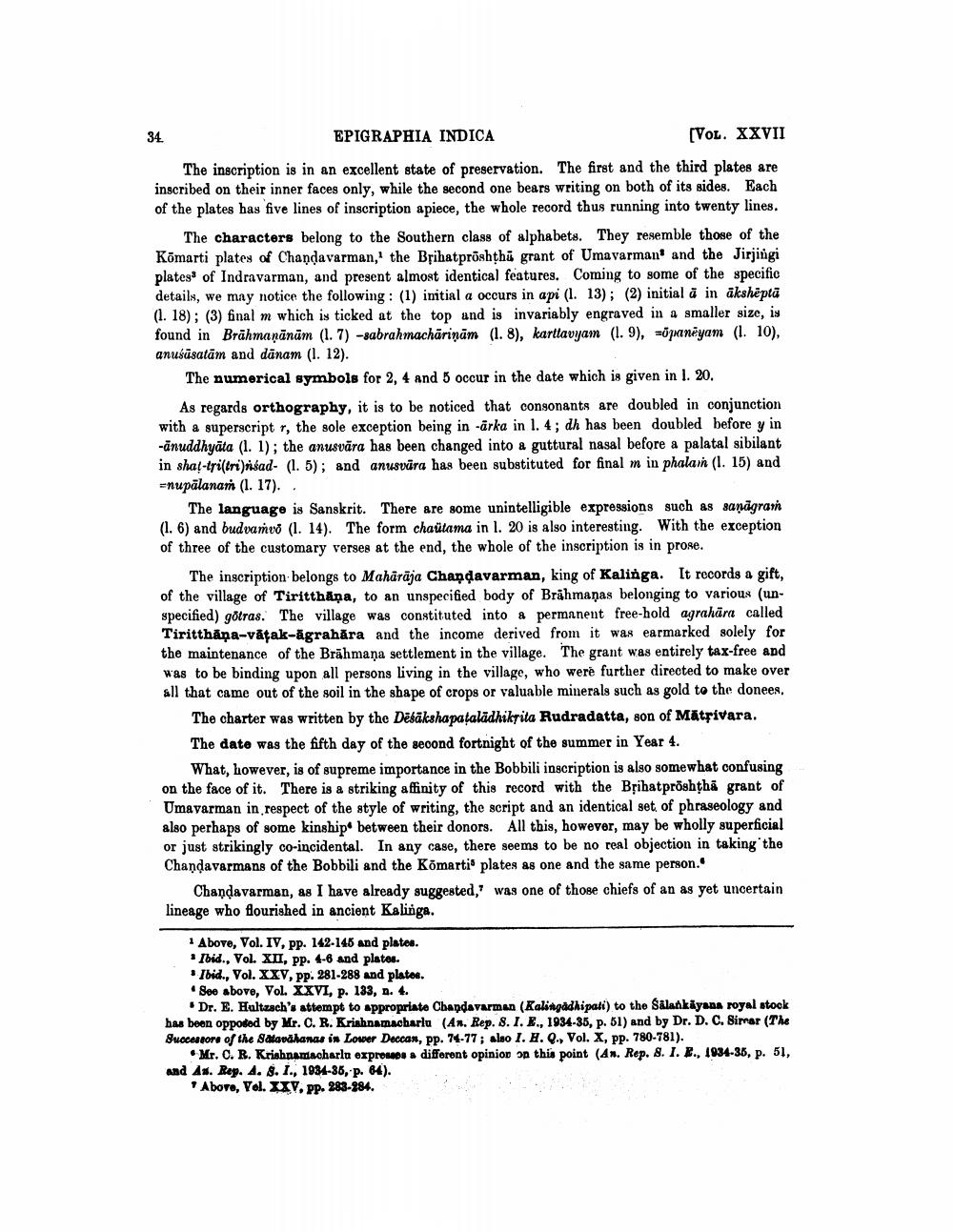________________
EPIGRAPHIA INDICA
(VOL. XXVII
The inscription is in an excellent state of preservation. The first and the third plates are inscribed on their inner faces only, while the second one bears writing on both of its sides. Each of the plates has five lines of inscription apiece, the whole record thus running into twenty lines.
The characters belong to the Southern class of alphabets. They resemble those of the Komarti plates of Chandavarman,' the Brihatproshthì grant of Umavarman and the Jirjingi plates of Indravarman, and present almost identical features. Coming to some of the specific details, we may notice the following: (1) initial a occurs in api (1. 13); (2) initial à in ākshēptā (1. 18); (3) final m which is ticked at the top and is invariably engraved in a smaller size, is found in Brāhmaṇānām (1.7) -sabrahmachāriņām (1.8), kartlavyam (1.9), opaneyam (1. 10), anuśūsatām and dānam (1. 12).
The numerical symbols for 2, 4 and 5 occur in the date which is given in l. 20.
As regards orthography, it is to be noticed that consonants are doubled in conjunction with a superscript r, the sole exception being in -arka in 1. 4; dh has been doubled before y in -ānuddhyāta (1.1); the anusvāra has been changed into a guttural nasal before a palatal sibilant in sha!-triltri)nsad- (1.5); and anusvüra has been substituted for final m in phalain (1. 15) and =nupālanan (1. 17)..
The language is Sanskrit. There are some unintelligible expressions such as sanāgran (1.6) and budvaṁvo (1. 14). The form chaütama in l. 20 is also interesting. With the exception of three of the customary verses at the end, the whole of the inscription is in prose.
The inscription belongs to Mahārāja Chandavarman, king of Kalinga. It records a gift, of the village of Tiritthåņa, to an unspecified body of Brāhmaṇas belonging to various (unspecified) götras. The village was constituted into a permanent free-hold agrahāra called Tiritthāņa-vățak-āgrahāra and the income derived from it was earmarked solely for the maintenance of the Brāhmana settlement in the village. The grant was entirely tax-free and was to be binding upon all persons living in the village, who were further directed to make over all that came out of the soil in the shape of crops or valuable minerals such as gold to the donees.
The charter was written by the Desākshapatalādhikrita Rudradatta, son of Mātrivara. The data was the fifth day of the second fortnight of the summer in Year 4.
What, however, is of supreme importance in the Bobbili inscription is also somewhat confusing on the face of it. There is a striking affinity of this record with the Brihatproshtha grant of Umavarman in respect of the style of writing, the script and an identical set of phraseology and also perhaps of some kinship between their donors. All this, however, may be wholly superficial or just strikingly co-incidental. In any case, there seems to be no real objection in taking the Chandavarmans of the Bobbili and the Kōmartis plates as one and the same person.
Chandavarman, as I have already suggested, was one of those chiefs of an as yet uncertain lineage who flourished in ancient Kalinga.
Above, Vol. IV, pp. 142-145 and plates. * Ibid., Vol. XII, pp. 4-6 and platos.
Ibid., Vol. XXV, pp. 281-288 and plates. See above, Vol. XXVI, p. 133, n. 4.
Dr. E. Haltzsch's attempt to appropriate Chanda varmen (Kalingadhipati) to the Salankayans royal stock has been opposed by Mr. C. R. Krishnamacharla (An. Rep. 8. I. E., 1934-35, p. 51) and by Dr. D. C. Simar (The Succestors of the dardhanas in Lower Deccan, pp. 74-77; slo 1. H. Q., Vol. X, PP. 780-781).
. Mr. C. R. Krishnamacharla exproses different opinion on this point (An. Rep. 8. I. E., 1934-36, p. 51, and As. Reg. 4. 8. 1., 1934-36, p. 64).
*Aboro, Vol. XV. pp. 283-984.




